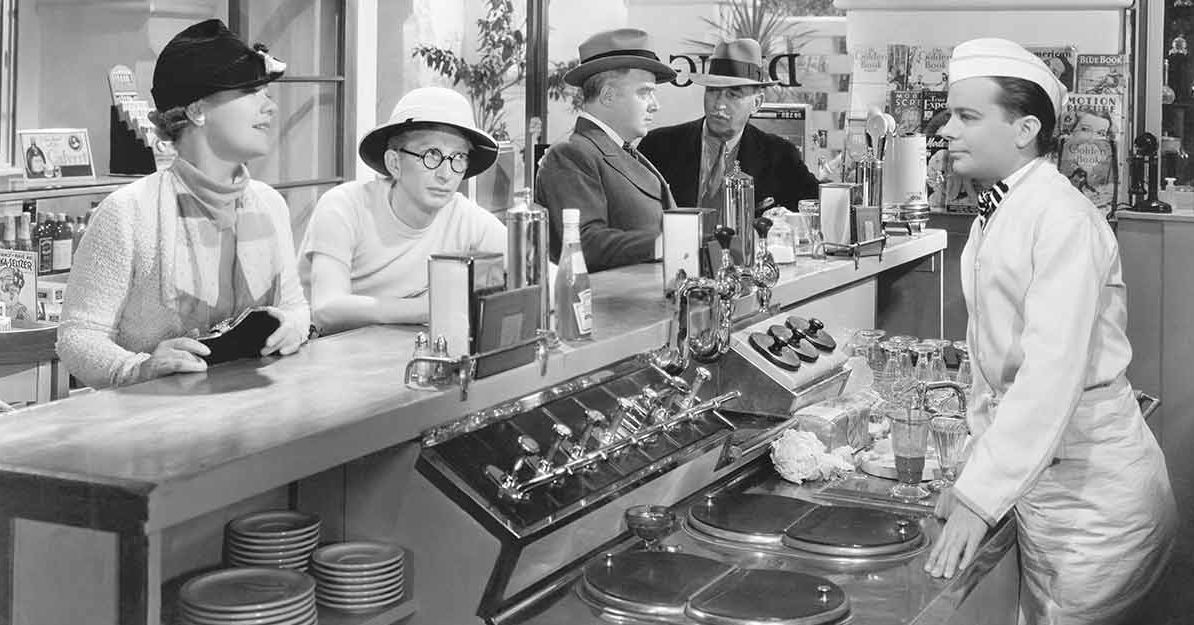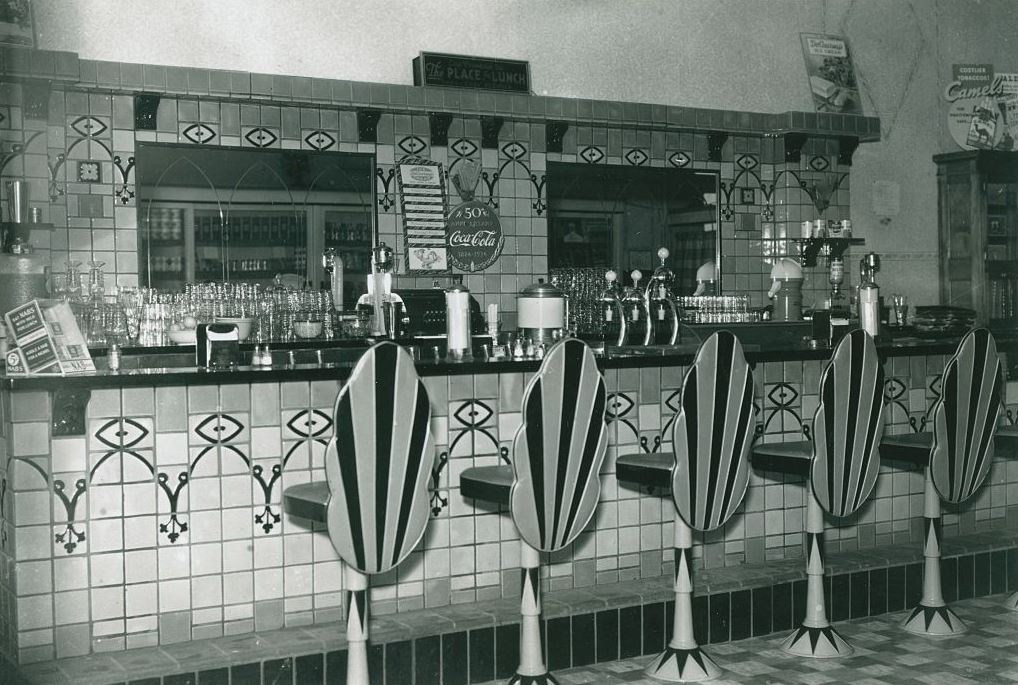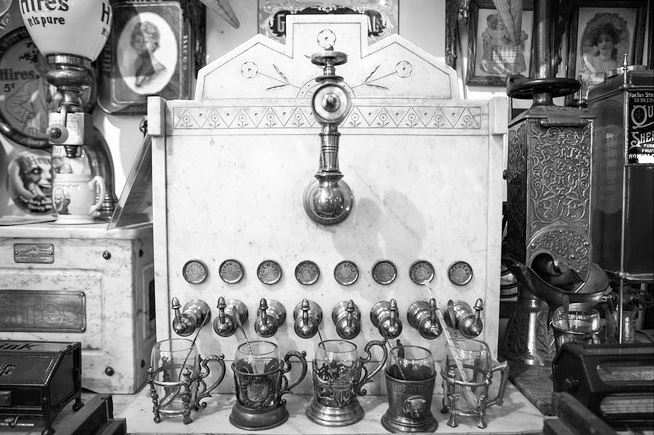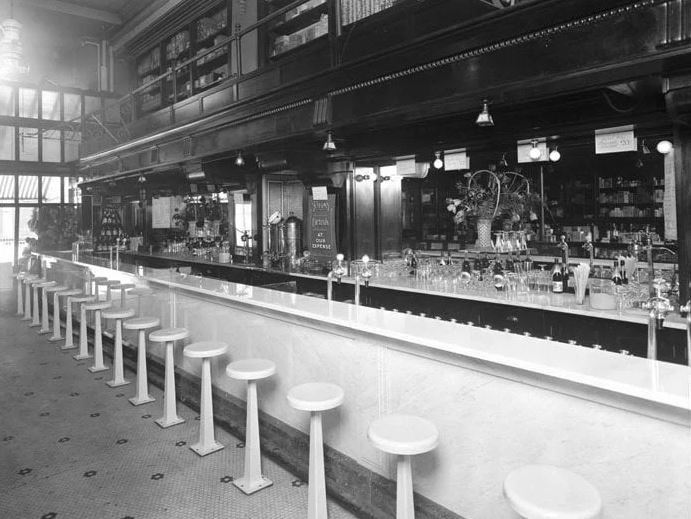The Evolution and Cultural Impact of Soda Fountains
A soda fountain, historically, is more than just a device for dispensing carbonated drinks; it is a cultural icon that has its roots deeply embedded in the fabric of social life, particularly in America. Originally developed to emulate the natural mineral waters thought to have healing properties, the soda fountain began as a simple mechanism for carbonating water. Over time, it evolved into a complex apparatus capable of dispensing a variety of flavored beverages.
The origins of the soda fountain date back to the 18th century, with significant developments occurring in the early 19th century. Chemists and inventors in Europe and America experimented with techniques to infuse water with carbon dioxide. The resultant effervescent water was initially celebrated for its supposed medicinal benefits. By the mid-1800s, these fountains featuring carbonated water were common in pharmacies, where they were used to prepare and serve mineral water concoctions enhanced with herbal and fruit syrups.
The cultural significance of soda fountains burgeoned in the late 19th and early 20th centuries. Positioned inside pharmacies, candy stores, and general stores, they became central fixtures in communities, serving as gathering places for people of all ages. The soda fountain offered more than just refreshment; it was a venue for social interaction and community engagement. During this era, the role of the “soda jerk”—the colloquial term for the soda fountain operator—emerged as a prominent one. These skilled individuals not only mixed the drinks but also played the role of host, enhancing the social experience with their flair and conversational skills.
As integral parts of the social landscape, soda fountains witnessed and contributed to the shaping of societal norms and interactions. They were democratic spaces where people from various walks of life could converge over a glass of soda. The decline of these establishments began in the mid-20th century with changes in consumer habits and business models, but their legacy persists, influencing modern beverage service and continuing to evoke a sense of nostalgia.
| Aspect | Details |
|---|---|
| Origin | Developed to emulate healing properties of natural mineral waters; began as a mechanism for carbonating water in the 18th century. |
| Evolution | Evolved from a simple carbonating device to a complex apparatus for dispensing flavored beverages by the 19th century. |
| Medicinal Use | Initially celebrated for supposed medicinal benefits; common in pharmacies by mid-1800s to serve concoctions with syrups. |
| Cultural Significance | Became a cultural icon in late 19th and early 20th centuries, serving as community gathering places within pharmacies and stores. |
| Role of Soda Jerks | Soda jerks played a crucial role as both beverage mixers and social hosts, enhancing the interactive experience at soda fountains. |
| Decline and Legacy | Decline began in mid-20th century with changes in consumer habits; legacy persists in modern beverage service and nostalgia. |
Contents
What is a Soda Fountain?
A soda fountain is a device that dispenses carbonated beverages. It traditionally mixes a variety of flavored syrup with carbonated water (soda water) to produce soft drinks on demand. Historically, these devices have been a staple in pharmacies, ice cream parlors, and diners, offering a refreshing treat to patrons while doubling as a social gathering spot.
The primary components of a soda fountain include:
- Syrup Concentrate: This is the flavor base of the beverage. It comes in numerous varieties ranging from classic cola to root beer and fruity flavors. The syrup is stored in a container often referred to as a “bag-in-box.”
- Carbon Dioxide (CO2): This gas is essential for carbonating the water. It adds the fizz that characterizes soda drinks, creating a refreshing sensory experience.
- Chilled and Purified Water: The quality of water is crucial, as it makes up the majority of the beverage. It is typically filtered and chilled to ensure the drink is both tasty and refreshing.
- Dispensing Mechanisms: These include taps and levers in manual soda fountains, or buttons and software-controlled mixers in automated systems.
Manual soda fountains are typically operated using a lever or push-button that controls the release of syrup and carbonated water. The operator (soda jerk) manually determines the proportions of syrup and soda water, allowing for customized drinks.

Automated vending machines, also known as postmix machines, are modern interpretations of the soda fountain. These use computerized systems to precisely mix syrup and carbonated water based on predefined settings. They are commonly found in fast-food restaurants and cinemas and allow for a consistent product with minimal human intervention.
| Component | Description |
|---|---|
| Syrup Concentrate | Flavor base of the beverage, available in a variety of flavors like cola, root beer, and fruity options, stored in “bag-in-box” containers. |
| Carbon Dioxide (CO2) | Essential for carbonating water, adds the characteristic fizz to soda drinks. |
| Chilled and Purified Water | Makes up the majority of the beverage; water quality is crucial and is typically filtered and chilled. |
| Dispensing Mechanisms | In manual systems, includes taps and levers; in automated systems, includes buttons and software-controlled mixers. |
| Operation Types | Manual soda fountains require operator control for drink customization; automated systems (postmix machines) use computerized settings for consistency. |
Historical Development
The inception of soda fountains can be traced back to Europe’s fascination with mineral waters. Believed to possess curative properties, these naturally carbonated waters were emulated artificially by inventing mechanisms to carbonate water.
In the 18th century, European scientists such as Joseph Priestley pioneered methods to infuse water with carbon dioxide. Priestley’s work, among others, paved the way for the development of artificial carbonated water, which was initially consumed for its supposed health benefits.
The concept of carbonated water was introduced to America by Benjamin Silliman, a professor at Yale University. In 1806, Silliman began selling carbonated water in New Haven, Connecticut, after purchasing a Nooth apparatus used for carbonating water. This marked the beginning of carbonated water’s commercialization in the United States.
Initially, soda fountains simply provided carbonated water, which customers could enhance with a variety of natural syrups, typically handmade from fruits, herbs, or roots. This customization aspect was crucial, as it allowed for a broad range of flavors and combinations, catering to individual preferences and leading to the creation of many of the classic soda flavors known today.
Numerous inventors and entrepreneurs contributed to the evolution of the soda fountain. John Matthews and John Lippincott significantly impacted the industry in the 1830s by improving the efficiency and reliability of soda fountains. Their innovations helped spread the popularity of these devices across the United States, setting the stage for the golden age of the soda fountain.
As technology advanced, so did the soda fountain. Innovations in refrigeration and carbonation led to more sophisticated systems, capable of dispensing a variety of drinks at the push of a button. These advancements have made soda fountains a beloved feature in many social settings, symbolizing innovation and enjoyment in American culture.
| Historical Aspect | Details |
|---|---|
| Origins in Europe | Originated from the fascination with mineral waters believed to have curative properties; Joseph Priestley and others pioneered carbonating water in the 18th century. |
| Introduction in America | Benjamin Silliman began commercializing carbonated water in 1806 in New Haven, Connecticut, using a Nooth apparatus. |
| Customization and Flavors | Early soda fountains offered carbonated water with a variety of natural syrups, leading to the creation of classic soda flavors. |
| Significant Contributors | John Matthews and John Lippincott in the 1830s improved the technology, enhancing efficiency and reliability, spreading popularity in the US. |
| Technological Advancements | Innovations in refrigeration and carbonation led to more sophisticated soda fountains capable of dispensing a variety of drinks automatically. |
| Cultural Significance | Soda fountains became a symbol of innovation and enjoyment, integral to social settings in American culture. |
The Golden Age of Soda Fountains Via Video Introduction
The late 19th century to the mid-20th century marked the golden age of soda fountains in the United States. These devices, often ornately designed, became a fixture in American drugstores and diners, symbolizing a unique blend of social interaction, innovation, and indulgence. Soda fountains were not just about serving drinks; they provided a vibrant communal space that fostered social connections and became integral to everyday American life.
Originally installed in pharmacies, soda fountains served medicinal tonics and carbonated waters believed to aid digestion and boost health. However, they quickly evolved into popular entertainment spots, offering more than just health benefits. Pharmacies and diners with soda fountains became local hotspots where people of all ages gathered. The atmosphere around these fountains was lively, filled with the clinking of glasses and the buzz of conversation, making them pivotal in the social fabric of communities.
Soda fountains served as communal gathering spots where people met for leisure and enjoyment. They were democratic spaces, transcending social and economic boundaries. Teenagers found them especially appealing as places to meet friends, enjoy a soda or a milkshake, and listen to popular music. The presence of a soda fountain often meant a safe, welcoming environment where family and friends could spend time together.
Soda fountains significantly influenced American cuisine and popular culture. They introduced a variety of beverages and treats that became staples, such as ice cream sodas, sundaes, and the famous egg cream, which contains neither eggs nor cream but is a delightful mixture of milk, carbonated water, and chocolate syrup. These treats not only satisfied the palate but also sparked trends that spread across the country. The ice cream soda, in particular, became so popular that it led to the creation of the ice cream sundae, reportedly invented when blue laws prohibited the sale of soda on Sundays.
| Aspect | Description |
|---|---|
| Golden Age | Late 19th century to mid-20th century; soda fountains became ornate fixtures in American drugstores and diners. |
| Function and Evolution | Originally served medicinal tonics and carbonated waters; evolved into centers of social interaction and entertainment. |
| Social Role | Provided vibrant communal spaces fostering social connections, transcending social and economic boundaries. |
| Popularity Among Youth | Especially appealing to teenagers as places to meet, enjoy beverages like sodas and milkshakes, and listen to music. |
| Cultural Influence | Influenced American cuisine and popular culture; introduced treats like ice cream sodas, sundaes, and egg creams. |
| Iconic Treats | Ice cream soda led to the creation of the sundae; these treats sparked nationwide trends and culinary innovations. |
Technological Advances and Industry Dynamics
The advancement of technology brought significant changes to the soda fountain industry, enhancing both the efficiency and the appeal of these devices.
The advent of mechanical refrigeration was a pivotal development for soda fountains. Before its introduction, ice was used to chill drinks and ice cream, which was logistically challenging and inconsistent. Mechanical refrigeration allowed for the consistent cooling of beverages and the preservation of ice cream, which in turn helped soda fountains become year-round fixtures rather than seasonal operations. This technological improvement not only enhanced the quality and variety of the offerings but also reduced costs and increased profits for operators.

During the golden age, several major manufacturers emerged, each contributing innovations that propelled the industry forward. Innovations included automated dispensing systems, which allowed for more precise mixing of syrups and carbonated water, and the introduction of iceless fountains, which utilized brine or ammonia to cool the water instead of ice. These advancements made soda fountains more reliable and easier to maintain, leading to widespread adoption in various retail settings.
The industry’s growth led to the formation of the American Soda Fountain Company in 1891, a conglomerate formed by four major manufacturers—Tufts, Puffer, Lippincott, and Matthews. This company was initially successful in monopolizing the market, controlling prices, and setting standards within the industry. However, as competition increased and antitrust sentiments grew, the company eventually dissolved, paving the way for innovation from smaller competitors and new entrants to the market. The dissolution allowed for further diversification and innovation within the industry, which continued to thrive until changes in consumer habits and new business models in the mid-20th century began to challenge the traditional soda fountain model.
In summary, the history of soda fountains during their golden age reflects a period of vibrant cultural significance and rapid technological advancement, leaving a lasting legacy on American society and the food industry.
| Technological Advancement | Impact on Industry |
|---|---|
| Mechanical Refrigeration | Enabled consistent cooling of beverages and preservation of ice cream, transforming soda fountains into year-round operations and enhancing the quality and variety of offerings. |
| Automated Dispensing Systems | Allowed more precise mixing of syrups and carbonated water, making soda fountains more reliable and easier to maintain. |
| Iceless Fountains | Utilized brine or ammonia instead of ice to cool the water, further simplifying maintenance and operation. |
| Formation of the American Soda Fountain Company (1891) | Consolidated major manufacturers, controlled prices and set industry standards initially, but later dissolved due to increased competition and antitrust pressures. |
| Impact on Society | The soda fountain’s technological advancements contributed to its cultural significance, making it a symbol of innovation and a centerpiece in American social life. |
Decline and Modern Resurgence
The decline of traditional soda fountains during the latter half of the 20th century was influenced by several key factors. One significant driver was the rise of self-service models, exemplified by the proliferation of fast-food restaurants and convenience stores. These venues favored vending machines and pre-packaged beverages that catered to the increasing consumer preference for speed and convenience, reducing the demand for the personalized service offered by soda fountains.
Additionally, changes in consumer behavior, influenced by increasing health consciousness and a shift towards more modern dining experiences, played a critical role. As people became more health-aware, the high-sugar content of soda fountain treats became less appealing. Furthermore, the suburbanization of America led to changes in how communities interacted, with malls and fast-food chains replacing local diners and drugstores as communal hubs.
Despite these changes, there has been a modern resurgence in the popularity of soda fountains, driven by nostalgia and a renewed interest in artisanal and craft beverages. Modern adaptations such as the Coca-Cola Freestyle machine have revolutionized the concept by allowing customers to mix their custom beverages from a variety of over 100 different options, all from a single machine. This technology blends the appeal of traditional soda fountains with modern demands for diversity and convenience.
Moreover, many contemporary restaurants and bars have reintroduced classic soda fountains, often featuring locally sourced syrups and natural ingredients, catering to the modern palate that favors artisanal and bespoke products. This resurgence is not only a nod to nostalgia but also an embrace of slow food and craft beverage movements, where the history and story behind the drink are as important as the taste.
Today, vintage soda fountains can still be found operating in various parts of the world, often in historic diners, museums, or as part of retro-themed establishments. These preserved models serve as cultural artifacts, offering a window into the past and a taste of a bygone era. Additionally, some new establishments mimic the old-fashioned soda fountain vibe to offer a unique, nostalgic experience to their patrons, complete with traditional soda jerks and classic menu offerings.
| Factor | Impact |
|---|---|
| Rise of Self-Service Models | Increase in fast-food restaurants and convenience stores with vending machines reduced demand for personalized soda fountain service. |
| Changes in Consumer Behavior | Health consciousness and modern dining preferences led to a decline in popularity due to the high sugar content of traditional offerings. |
| Suburbanization | Malls and fast-food chains became the new communal hubs, shifting social gatherings away from local diners and drugstores. |
| Modern Resurgence | Nostalgia and interest in artisanal beverages have revived soda fountains, with innovations like the Coca-Cola Freestyle machine offering customization. |
| Contemporary Adaptations | Restaurants and bars reintroduce soda fountains featuring local, natural ingredients, aligning with slow food and craft beverage trends. |
| Cultural Preservation | Vintage soda fountains operate in historic settings and retro-themed establishments, serving as cultural artifacts and providing nostalgic experiences. |
Soda Fountains in Global Context
The culture around soda fountains varied significantly across different regions. In the Eastern Bloc, for example, soda fountains did not just serve as leisure spots but also as practical solutions to beverage needs in a controlled economy. These fountains were often simpler and more utilitarian compared to their ornate American counterparts.
In Russia and other former Soviet countries, unique vending machines known as “soda fountains” were widespread. Unlike the American versions, these machines dispensed carbonated water for a small fee, and customers often added syrup from a separate dispenser. This practice was both economical and aligned with the socialist ethos of providing basic goods in an accessible manner.

One of the more distinctive features of soda fountains in places like Russia was the communal glass. Customers would drink directly from a communal glass, which they would rinse in water before and after use. This practice, unthinkable in many other cultures due to hygiene concerns, was commonplace and reflected a different social trust and communal approach to sharing.
Moreover, the design and mechanics of these machines were often tailored to suit the economic and social conditions of the countries in which they were found. For example, the robust design of Soviet soda machines made them capable of operating in various climatic conditions and required minimal maintenance, reflecting the need for durability and reliability over aesthetics or variety.
In summary, while the golden age of soda fountains in the U.S. was marked by extravagance and community-building, the global context of soda fountains reveals a diverse tapestry of cultural practices, each adapting the basic concept of carbonated water to fit local tastes, economic conditions, and social norms.
| Region | Characteristics | Cultural Context |
|---|---|---|
| Eastern Bloc (e.g., Russia) | Utilitarian design, commonly featured communal glasses, and separate syrup dispensers. | Served as practical beverage solutions in a controlled economy; aligned with socialist values of accessibility and economy. |
| Distinctive Features | Communal glass usage, robust machine design suitable for various climates, minimal maintenance required. | Reflected a different social trust and communal approach to sharing; designed to be durable and reliable, prioritizing function over aesthetics. |
| Global Comparison | Simpler and more economical compared to ornate American counterparts. | Shows adaptation of the soda fountain concept to local economic conditions, tastes, and social norms, highlighting a diverse global culture around soda fountains. |
Soda Fountains in Literature and Popular Culture
Soda fountains have long been a staple in the tableau of American nostalgia, frequently appearing in literature and film as symbols of innocence, community, and simpler times. Their portrayal often evokes a sense of warmth and quaintness, reminiscent of a bygone era of sock hops and poodle skirts.
In literature, soda fountains are often depicted as the heart of small-town life, a place where characters gather to exchange gossip, fall in love, or plot their next adventures. This setting serves as a backdrop for pivotal moments, symbolizing a space where community bonds are both formed and tested. Films, especially those set in the mid-20th century, mirror this portrayal. Classics like “American Graffiti” and television shows such as “Happy Days” depict soda fountains as central hubs of teenage social life, where characters interact with the iconic soda jerk who often acts as an informal counselor.

Moreover, the visual and emotional appeal of soda fountains, with their shiny chrome taps and colorful array of syrup bottles, lends itself well to the visual mediums of film and television, making it a favored setting for scenes conveying nostalgia and comfort.
Neil Munro, in his piece “The Soda-Fountain Future,” provides a unique, satirical take on the soda fountain culture. Published in the early 20th century, Munro’s work critiqued the Americanization of Scottish culture, humorously bemoaning the replacement of traditional Scottish pubs with American-style soda fountains. His portrayal reflects a skepticism about cultural change, using the soda fountain as a metaphor for the broader shifts in societal values and norms brought about by globalization and American cultural influence. Through his satire, Munro captures the ambivalence felt by many towards this cultural import, viewing it both as a symbol of modern convenience and as a threat to traditional ways of life.
| Medium | Portrayal | Symbolic Significance |
|---|---|---|
| Literature | Depicted as the heart of small-town life, a setting for pivotal social interactions like gossip, romance, and plotting. | Symbolizes community bonds, serving as a cultural space where these bonds are formed and tested. |
| Film and Television | Central hubs of teenage social life in classics like “American Graffiti” and “Happy Days,” featuring interactions with soda jerks. | Evokes nostalgia and a sense of innocence; represents a simpler, idealized past. |
| Social Commentary | Neil Munro’s “The Soda-Fountain Future” uses satire to critique the Americanization of Scottish culture, symbolizing modern convenience vs. traditional life. | Used as a metaphor for cultural shifts and the impact of globalization on local traditions and societal values. |
The enduring appeal of soda fountains lies in their rich blend of history, nostalgia, and cultural significance. They evoke a sense of continuity with the past, providing a tangible link to a time when life seemed simpler and more straightforward. Despite changes in technology and consumer habits, soda fountains continue to hold a special place in the cultural memory, cherished for their aesthetic and the personal interactions they fostered.
In modern-day culture, soda fountains serve dual roles. As nostalgic artifacts, they are preserved and celebrated in museums, themed restaurants, and films, offering a window into the past and a space for communal nostalgia. At the same time, they have evolved technologically, exemplified by devices like the Coca-Cola Freestyle machine, which represents the modern iteration of the traditional soda fountain. These modern machines harness advanced technology to offer a wide array of choices and conveniences, meeting contemporary needs while maintaining the charm and appeal of their predecessors.
Thus, soda fountains exemplify a unique blend of tradition and innovation, appealing to both sentiment and modernity. They remind us of a shared heritage while continuously adapting to current tastes and technologies, proving that even the most ordinary of objects can have a lasting impact on both individual lives and broader cultural landscapes.
Knowledge -Therapis A Unique Genus in the Family Geometridae
Paolo Canevari Symbols, Myths, and Modern Art
Exploring the Traditional British Dish Faggots
Exploring the Many Facets of Camou
The Evolution of the Primary School Leaving Examination
Newkirk Plaza Station A Century of Service and Renovation
Versatility of the Term Droopsnoot From Aircraft
